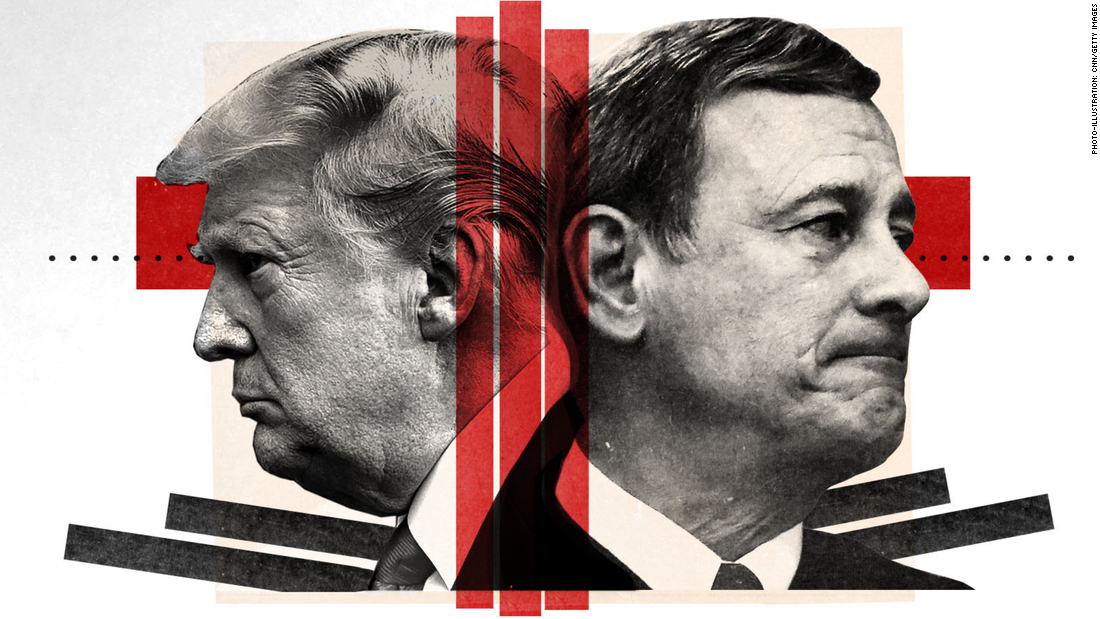But the vote among the justices was close, and the narrow margin did not satisfy Roberts — or his colleagues.
They wanted a coalition of liberal and conservative justices — as much ideological unity as possible — for the decisions regarding presidential power, four sources with knowledge of the internal deliberations told CNN. It would take nearly two months to produce the two 7-2 rulings.
The justices could not purge Trump from their thinking, the sources told CNN, but they were aware that these disputes were not just about him. During their deliberations, CNN has learned, the justices struggled to balance the interests of the executive branch and those of Congress, and criminal prosecutors, seeking records — from any president.
Together, the final decisions represented a masterstroke of mutual interests that in these polarized times avoided a direct clash with Trump.
The cases encapsulated the tense conflict between the Roberts court, searching for principles that would endure for years, and Trump, making clear he views any ruling against him or his administration as a personal affront.
The President has often railed against Roberts and suggested by his own partisan-soaked remarks about the judiciary that he expects the court’s four Democratic-appointed justices to automatically rule against him and his two appointees to deliver for him. In the end, all of those justices voted against Trump in significant parts of the cases over his financial documents.
In the Trump subpoena cases, the justices had a particular reason to sweat a narrow vote. In such moments involving presidential privileges, the Supreme Court had in the past set aside ideological and political differences and produced unanimous rulings.
In 1974, the court required President Richard Nixon to turn over Watergate tapes. In 1997, the court’s action led to President Bill Clinton’s testimony in Paula Jones’ sexual harassment civil lawsuit and, through separate US House proceedings, his eventual impeachment.
Roberts and his colleagues were clear-eyed about the fact that both cases were decided unanimously against each president. And they recognized that the judiciary in recent months had been in the crosshairs of partisans on both sides, sources told CNN.
As Trump and others in the GOP have blasted the court, liberal advocates have questioned its institutional integrity and have floated “court packing” proposals for ideological balance.
Further, the justices understood that the politics of the current document ordeal could be flipped in a matter of years, even months: A Democratic president could be trying to fight off a GOP-controlled House or state prosecutors.
The US House lawsuits arose from attempts by Democratic-led committees to obtain financial records that members contended would help them write new ethics legislation. Subpoenas were directed at Trump’s accountants Mazars USA and two of his financial institutions, Deutsche Bank and Capital One.
Trump’s case against Manhattan District Attorney Cy Vance stemmed from a New York grand jury’s investigation of whether Trump, before becoming President, directed “hush money” to women who claimed to have had affairs with him. (Trump has denied the affairs.)
In the short term, the practical effect appears to be that Trump has the ability to keep the files sealed until after the November election.
Politics in the air
Both sides told the justices that the court had the ability and responsibility to decide the subpoena dilemmas.
Kavanaugh’s colleagues on the bench ultimately were not enticed by the idea either.
In a case that could have dramatic effects on the presidency in an election year, the court initially was stalled. Arguments had been scheduled for March, but because of the coronavirus pandemic they were put off until May 12 and held via telephone.
And no matter how much a court majority worked to break free of their views of Trump, some inclinations were heard in the three hours of teleconference arguments, broadcast live to the public.
Thomas characterized the third-party subpoenas in the House case as personal to Trump. The true intention, Thomas suggested, was “to remove the President from office.”
His wife, Virginia “Ginni” Thomas, has been an especially visible Trump loyalist. She was among the President’s supporters invited to an East Room celebration in February after his Senate acquittal of the articles of impeachment brought by the US House.
Coming from the opposite direction, liberal Ginsburg, during the livestreamed hearing, emphasized holes in Trump’s arguments. If Congress is to fulfill its legislative mission, she said, it must first be able to investigate. (House leaders insisted they needed Trump’s financial materials to write new ethics legislation, including to prevent foreign influence in US elections.)
Further revealing her views, Ginsburg asserted: “Every President voluntarily turned over his tax returns. So it gets to be a pitched battle here because President Trump is the first one to refuse to do that. And, initially, he said because an audit was ongoing. Now it seems to be broader than that.”
No guarantee the liberals would side with Roberts
In their private teleconference after the May arguments, sources told CNN, the justices were still dividing sharply, offering competing legal rationales and struggling with how far they wanted to go to shield the President or force him to produce materials.
As they first discussed the New York case, CNN has learned, the justices split 5-4 to affirm a lower court judgment against Trump and his lawyers’ assertion of immunity. Roberts, a 2005 appointee of President George W. Bush, and the four liberals were on one side, against the other four conservative justices.
In the House dispute, the justices began with a possible six-justice majority to throw out a lower court decision that had declared Congress has broad authority to investigate and issue subpoenas for the Trump financial documents as part of its legislative mission. But justices across the ideological spectrum raised concerns as they established their legal reasoning about the appropriate balance between congressional and presidential interests.
Liberal justices were worried about encroaching on Congress’ ability to carry out its oversight responsibilities and discouraging any cooperation between executive and legislative officials. Conservatives, meanwhile, wanted to guarantee that any congressional requests for executive documents would be limited and thoroughly justified.
When he is in the majority, the chief justice has the power to assign the opinion for the court. As Roberts does in most big-ticket cases, he kept both for himself.
As Roberts began drafting a compromise, according to sources, he initiated conversations with justices on both sides, toward the strongest majorities possible. At the start of internal debate over the House case, according to sources, it had not been evident that all four liberals would join his opinion and who among Roberts’ usual brethren on the right would help him strike a bargain.
The New York case, perhaps, was more straightforward, because of the extreme Trump assertion of “temporary presidential immunity,” along with settled precedent in that area of the law.
Several justices came to the cases with distinct experience in the executive or legislative branches: Roberts, Kavanaugh and Justice Elena Kagan had held high-level positions in presidential administrations: Roberts for Ronald Reagan and George H.W. Bush, Kavanaugh for George W. Bush, and Kagan for Bill Clinton and Barack Obama.
Roberts puts together a coalition
As Trump appointees, Kavanaugh and Justice Neil Gorsuch were traversing their own issues in the disputes over the President’s tax and financial records. They ended up fully joining Roberts and the liberals in the House case — perhaps offering a message of independence from the two “Trump judges” and reinforcing Roberts’ message of nonpartisanship.
Kavanaugh and Gorsuch signed on to Roberts’ bottom-line judgment against Trump’s contention of immunity in the Trump v. Vance case but offered a separate opinion explaining that they would, however, require a heightened standard for prosecutors asserting they need to subpoena private papers from a president.
In the consolidated House cases, Roberts similarly minimized differences. He conferred with liberals to satisfy their concerns about congressional power, according to sources. They shared the chief’s desire to send a message to the public that they were not hewing to predictable ideologies.
The majority declared that Congress had the authority to obtain information for its legislative mission. But, Roberts wrote, the House had not sufficiently demonstrated in lower court proceedings that it needed Trump’s financial records for its legislative goals. Roberts also said that lower court judges who had previously heard Trump’s objections to the subpoenas failed to sufficiently weigh possible separation-of-powers implications.
Six other justices signed on and no one chose to write a separate statement, as often happens in fractious cases. Regardless of where they had started, seven justices landed on the same page.
The chief justice underscored that one element of unanimity. Referring to the fact that a sitting president remains subject to the judicial process, the chief justice wrote: “On that point the Court is unanimous.”
In his opinion addressing Trump’s claim that he should be immune from the New York grand jury subpoena, Roberts used as his touchstone a decision by Chief Justice John Marshall, presiding over the treason trial of Aaron Burr, to permit a subpoena against President Thomas Jefferson.
Roberts, who before turning to law at Harvard considered earning a Ph.D. in history, plainly delighted in the opportunity to recall the Burr episode. He opened that section of his final opinion with, “In the summer of 1807, all eyes were on Richmond, Virginia. Aaron Burr, the former Vice President, was on trial for treason. Fallen from political grace after his fatal duel with Alexander Hamilton, and with a murder charge pending in New Jersey, Burr followed the path of many down-and-out Americans of his day — he headed West in search of new opportunity.”
In conclusion, Roberts wrote of Marshall, “Two hundred years ago, a great jurist of our Court established that no citizen, not even the President, is categorically above the common duty to produce evidence when called upon in a criminal proceeding.”
When the court delivered its decisions in the subpoena cases, Trump’s rebuttal rang of his prior objections to perceived affronts: “Courts in the past have given ‘broad deference’. BUT NOT ME!”
Those were the last decisions to be announced for the pivotal term.
Uncertainty for the nine
The nine justices usually close out their annual term with a festive party and games organized by law clerks and with tickets to far-flung vacation spots. (In the past, the games have included a “Jeopardy!”-like trivia contest, with clerks divided up into teams.) But there was none of that this July, as the coronavirus pandemic had already forced them into nine isolated locales and crimped travel plans.
The circumstances of Covid-19 had added to the difficulties of the historic session. They had not been able to walk the marble halls and drop in on one another’s chambers to converse informally on cases. They’d had to introduce concerns, instead, in their stiffer teleconference meetings.
And there seemed only uncertainty ahead. The justices lost the usual sense of relief when decisions were over in early July, sources told CNN, because the court faced immediate emergency petitions related to imposition of the federal death penalty, new state ballot controversies and more religious objections to state pandemic restrictions.
The justices anticipated continued controversies related to the election year, sources said.
Looming over it all, according to sources, was the awareness that the presidential election could have direct consequences for the court itself. So could the coronavirus and other health threats. Six of the nine justices are 65 or older.
They had just completed a momentous session with sweeping consequences for government powers and life across America. As they considered what cases lie ahead, they wondered how much longer they would all be together, even while apart.

Reader. Organizer. General creator. Zombie fanatic. Alcohol advocate. Food junkie. Bacon ninja.





